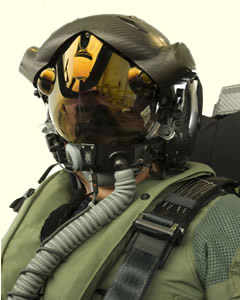A Helmet Mounted Display System (HMDS) made by Vision Systems International, LLC (VSI) recently flew for the first time on an F-35 Joint Strike Fighter aircraft. It was worn by Lockheed Martin’s Jon Beesley, who piloted the advanced fighter. The HMDS provides the pilot video with imagery in day or night conditions combined with precision symbology to give the pilot situational awareness and tactical capability. Also, by virtue of precise head tracking capability and low latency graphics processing, it provides the pilot with a virtual heads-up display (HUD). As a result, the F-35 is the first tactical fighter jet in 50 years to fly without a HUD.
“Since the F-35 has no HUD, providing virtual HUD capability has become a mandatory requirement, entailing precise head tracking and display operation near zero latency. We are proud to be a key partner to the F-35 industrial and government team,” said VSI President Drew Brugal.
The HMDS provides critical flight information to the pilot throughout the entire mission. In addition to standard HMD capabilities, such as extreme off-axis targeting and cueing offered on VSI’s other HMDs, Joint Helmet Mounted Cueing System (JHMCS) and Display & Sight Helmet (DASH), this system fully utilizes the advanced avionics architecture of the F-35.

The HMDS has been in development for five years and recently completed all required safety of flight tests, allowing in-flight seat ejections up to 450 KEAS (knots equivalent air speed). It has demonstrated structural integrity to 600 KEAS as a critical risk mitigation step towards full flight certification.
demonstrated structural integrity to 600 KEAS as a critical risk mitigation step towards full flight certification.
Principal suppliers include Elbit Systems Ltd. (ESL), which provides the Display Management Computer for the Helmet that contains advanced graphic processing and head tracking; Rockwell Collins, which builds the Helmet Mounted Display, including advanced optical design; and Helmet Integrated Systems Ltd. (HISL) of the United Kingdom, providing the helmet shell and pilot personal fitting system.
















